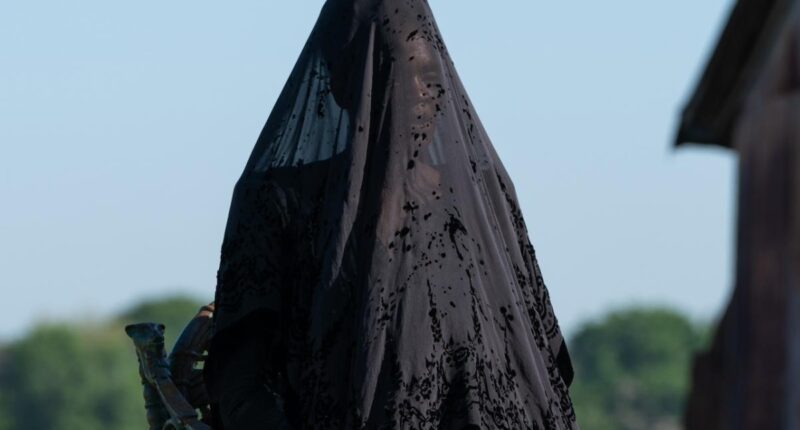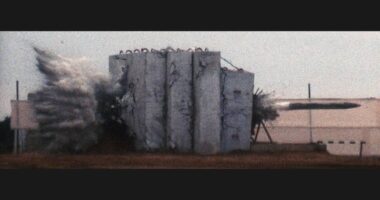The movie The Woman in the Yard may have a small scale with just one primary location and five main characters, but it sparks plenty of discussion. Directed by Jaume Collet-Serra, known for his recent Netflix hit Carry-On, the horror film follows the story of Ramona (played by Danielle Deadwyler) and her kids Taylor (Peyton Jackson) and Annie (Estella Kahiha). The plot revolves around a mysterious woman in black who appears on their farmhouse property, leading to questions about her intentions and presence. Collet-Serra masterfully builds tension through visually captivating techniques, creating an unsettling atmosphere that keeps viewers engaged alongside the family. While the ultimate answer to the mystery is revealed, the aftermath remains open to interpretation.

The Woman in the Yard prioritizes character development over a complex plot. The audience learns early on that Ramona is dealing with the recent loss of her husband David (Russell Hornsby) due to a car crash. This tragedy, symbolized by the wrecked car in their yard, haunts Ramona, who also carries guilt over surviving the accident. As the narrative unfolds, we witness Ramona’s struggles as a single mother trying to cope with daily challenges like a power outage at their farmhouse. The dynamics between Ramona and her children, Taylor and Annie, reflect the strain caused by grief and the absence of a father figure. When the mysterious woman enters their lives, tensions escalate, especially as she exerts an eerie influence over the shadows surrounding her.
Throughout the day, the woman’s cryptic warnings about “today’s the day” add to the ominous atmosphere. It becomes evident that she possesses supernatural abilities tied to revealing hidden truths. As she confronts Ramona with the reality of David’s death – implicating Ramona in the fatal accident following a heated argument – the boundaries between the real and the surreal blur. Ramona’s descent into a surreal world, marked by hallucinations and unsettling encounters, forces her to confront her inner demons and unresolved emotions. The intrusion of the woman and her powers into the household signals a transformative journey for Ramona, culminating in a climactic confrontation that challenges her perception of reality.
Basically, the farmhouse winds up haunted by Ramona’s own personal tumult. It becomes clear that she has unconsciously summoned the woman in the yard; she is a physical manifestation of Ramona’s clinical depression, which dates much further back than grief over losing David. Though Ramona claims to have been praying for the strength to get through the loss of her husband, the woman claims (seemingly correctly) that she was truly praying for the strength to end her own life. In the mirror world, the woman shows Ramona pictures of Taylor and Annie growing up, happy and healthy without their mother, who the woman says will only be a burden to them if she says alive. As night falls, Ramona (who has also experienced disturbing visions of harming her children) agrees that “today’s the day.” She sends the children away, takes a rifle into the barn, and sits there in solitude. What happens next is up for some debate.

Though Collet-Serra cuts to an exterior shot of the barn, priming us to expect a shot to ring out, we don’t hear anything. Instead, Taylor and Annie return, and Ramona emerges from the barn, seemingly back from the brink of her suicidal ideation. The woman has disappeared, and the kids ask whether she’ll be back. Ramona says that if the woman returns, she’ll be ready, and the family returns to their home together, implying that Ramona is determined to treat her illness.
However, a few things feel slightly amiss as this ending unfolds. One is that their home now has a sign with a name for their modest estate, something David and Ramona had discussed before his death. Another is that the house seems to be fully fixed up and in good repair; its halfway state was a point of contention between David and Ramona, as well as commented upon earlier that morning as a project now facing Ramona in the midst of her grief. Finally, the camera pushes in on one of Ramona’s paintings, which has an image of both herself and the woman. It’s also signed with Ramona’s name, using a backwards “R.”
It would be easy enough to interpret this as a sign that Ramona has entered a kind of mirror-world purgatory, easing her way into the afterlife after she did, indeed, follow through with her suicide; the house looks more idyllic than it had before, and part of her signature is backwards. Yet there are ambiguities in these images, too. Earlier, our glimpse of the mirror world included David; if this is a vision designed to placate Ramona, why would her husband still be dead? The painting, too, seems like a note of optimism; earlier in the film, we see Ramon’s artwork and it appears to be dominated by a shrouded figure like the woman. A painting that more clearly depicts Ramona herself, coexisting with the woman, seems like a reconciliation of her depression with the rest of herself, and her desire to live. The fixed-up house could be a smoothly integrated flash forward to a happier time; Collet-Serra uses all kinds of visual tricks in the movie to bleed together the past and present, and it wouldn’t be out of line for him to do that again, now depicting a happy ending.
Yet there is something that feels not quite real about this happiness and, indeed, a truly settled flash forward to Ramona finding the will to live might not focus so intently on that backwards “R.” (Though, again, that was something her daughter was doing, and could also be an homage to her or to her experiences on this day.) Ultimately, the film is ambiguous, fitting in with the ambiguity of how, exactly, this woman who is depression personified was even visible to Ramona’s kids. What actually happened in the physical world? The movie doesn’t really say.
In some ways, all of this feels like a cheat: a vague solution for a movie that doesn’t want to provide an unrealistically pat ending to a story about someone with severe clinical depression, but also doesn’t want to alienate its audience with an unbearably bleak finale. On the other hand, this dodge may be the film’s only satisfying path out of the hell Collet-Serra so expertly builds in Ramon’s head. Either bleakness or triumph would both feel pretty predictable; they could both, in fact, feel insulting in their own way. Instead, The Woman in the Yard forces its audience to live with the capacity for great relief and crushing sadness; even if it’s a little craven, it’s true to its tricky, audacious treatment of delicate subject matter. With so many horror movies content to offer easy “the monster is grief” metaphors, Collet-Serra has made a movie that’s more challenging.
Jesse Hassenger (@rockmarooned) is a writer living in Brooklyn podcasting at www.sportsalcohol.com. He’s a regular contributor to The A.V. Club, Polygon, and The Week, among others.
(function(d, s, id) {
var js, fjs = d.getElementsByTagName(s)[0];
if (d.getElementById(id)) return;
js = d.createElement(s); js.id = id;
js.src = “//connect.facebook.net/en_US/sdk.js#xfbml=1&appId=823934954307605&version=v2.8”;
fjs.parentNode.insertBefore(js, fjs);
}(document, ‘script’, ‘facebook-jssdk’));

















